2 Internationally Recognized Thought-Leaders – One Local, One Global; and, SMC
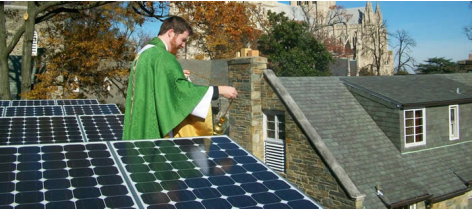
This post is about thought-leaders Chesapeake Bay Foundation and Google, and Apple. It’s particularly about renewable energy employed at facilities of these organizations.
It’s also intended to lead your thinking about renewable energy at St. Margaret’s Church, possibly on-site. (Read on for specifics.)
I mentioned in this blog awhile back, and including at an Adult Forum, some of the features of the Philip Merrill Center, headquarters of the Chesapeake Bay Foundation located in Bay Ridge. In 2000, the Merrill Center was awarded the highest level of building sustainability conferred by the U. S. Green Building Council’s 3rd-party certification platform, LEED® Platinum. First of its kind with as much as 30% of its energy requirement coming from on-site renewable sources. Almost ancient history now.
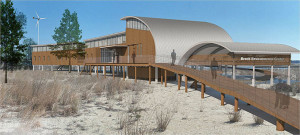
The CBF started constructing this summer a new 10,000 sq. ft. environmental education and community center building at Pleasure House Point, Virginia Beach, VA. The intention is that this facility, the Brock Environmental Center, will certify under the International Living Future Institute’s most rigorous, voluntary 3rd-party certification program, Living Building Challenge Certified. This is a major step beyond what was accomplished at the Merrill Center. Also targeted is LEED® Platinum certification.
The International Living Future Institute (ILFI) was founded a few years ago with “a mission to lead the transformation to a world that is socially just, culturally rich and ecologically restorative.”
Under ILFI’s certification programs are Living Building Challenge Certified (the most comprehensive), Petal Certified Projects and Net Zero Energy Certified Projects.
Within the Living Building Challenge Certified program, Net Zero must be applied both to energy and water. Meaning: all water and energy may only be derived on-site through catchment, recycling, and renewable resources—rather than from large-scale centralized public or private providers.
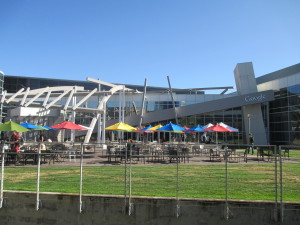 Google is designing a new world headquarters facility in Mountain View, CA, intended to be Living Building Challenge Certified. Headline: “Google’s New Headquarters Faces ‘Challenge’.” Branding, as it were, will be with Living Building Challenge Certification rather than the route of a signature building by an internationally renown architect for Apple at its new HQ.
Google is designing a new world headquarters facility in Mountain View, CA, intended to be Living Building Challenge Certified. Headline: “Google’s New Headquarters Faces ‘Challenge’.” Branding, as it were, will be with Living Building Challenge Certification rather than the route of a signature building by an internationally renown architect for Apple at its new HQ.
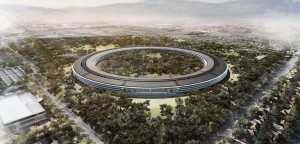 So, Apple just won local approval for what’s dubbed Apple Campus Two, a new 176-acre corporate headquarters designed by Norman Foster. From the Climate Progress blog: “The campus is anchored by a massive, circular building…providing approximately 2.8 million square feet of office space. That translates to more than 750,000 square feet of space on the building’s roof, nearly all of which will be comprised of solar panels.
So, Apple just won local approval for what’s dubbed Apple Campus Two, a new 176-acre corporate headquarters designed by Norman Foster. From the Climate Progress blog: “The campus is anchored by a massive, circular building…providing approximately 2.8 million square feet of office space. That translates to more than 750,000 square feet of space on the building’s roof, nearly all of which will be comprised of solar panels.
“Combined with on-site fuel cells and use of grid-purchased renewable energy during peak hours, Apple says that its new campus will be powered 100 percent by renewable energy and will not result in any net additional greenhouse gas emissions.”
Faith-based organizations are on it, too! ‘Though slowed by the lack of direct tax advantage.
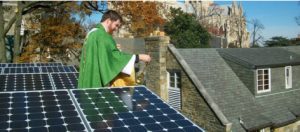
One on-site renewable energy example is the installation of roof-mounted PV solar panels at St. Alban’s Episcopal Church in Washington, DC. This event received national coverage in The Washington Post in the fall of 2009. Some factoids and advice about the St. Alban’s installation, along with same for 6 other houses of worship in the DC area, were featured by the Greater Washington Interfaith Power & Light Company in “Learning from Greater Washington’s Leading Solar Congregations” more recently.
Three take-aways from the experience at St. Alban’s, one realized already at SMC. (1) “Yes, you need leadership support, but the project should be owned by the laity. The pastor’s or priest’s vision has to be owned by the members. You have to have critical mass.” (2) “Impact on our congregation: This solar project ‘jump-started’ a number of larger initiatives including intensive recycling, and education about home energy audits and weatherization with WeatherizeDC. It also raised the visibility of younger people in the congregation.” (3) “In the contract, five years out, the church can exercise a ‘Put Option.’ We can analyze the costs or savings and exercise (or not) the option to purchase the equipment at a pre-determined cost.” “Let There Be Solar,” by Rt. Rev. Scott Benhase, is worth perusing. (Scroll to p. 6 of the linked GWIPL article).
The University Park Church of the Brethren, Hyattsville, found funding for its solar panels in an unusual way. A group of neighbors, whose homes were shaded by old trees, approached the church about solar power in the community. In the end, the neighbors formed and funded a neighborhood LLC which, to make a long story short, came to own the solar system on the church’s roof. Brings to mind SMC parishioners (and other like-minded area Episcopalians?) who might find the various owner/investor tax incentives of interest. Or, Crowdfunding…?
So, at St. Margaret’s Church, Annapolis, (SMC) there are carbon footprint offset options worth considering.
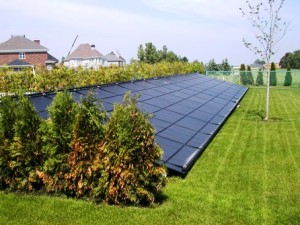
(1) A solar array ground-mounted with landscaped buffer at the south end of the open field, (a) sized to power the Formation Building, but likely dependent on successfully obtaining grants to pay for the system, or (b) sized according to the demands of solar system investors/owners under a PPA (Power Purchase Agreement) which we are advised would be about twice the size of (a). BTW, either of these would garner up to 9 points on our LEED scorecard.
(2) SMC could decide to purchase Green Power for minimum 35%, or up to 100%, of the Formation Building’s estimated needs for minimum 2 years. Through a provider such as Clean Currents or TerraPass, raw power can be purchased through the grid from a regional wind farm and transmitted through BGE’s infrastructure. This option could earn 2-3 points on the LEED scorecard. Presently, Green Power is being explored for all of the existing buildings on campus.
(3) SMC could opt for a smaller-sized solar array than in (1)(a) above, perhaps due to lesser grant money won, and purchase through the grid the additional renewable power to equate to about 100% of the Formation Building’s requirement. This option would also earn LEED scorecard points, depending on the size of the solar array and percent of Green-e purchased.
These options will be enumerated at the Adult Forum this Sunday, December 8th. Be there! (please)